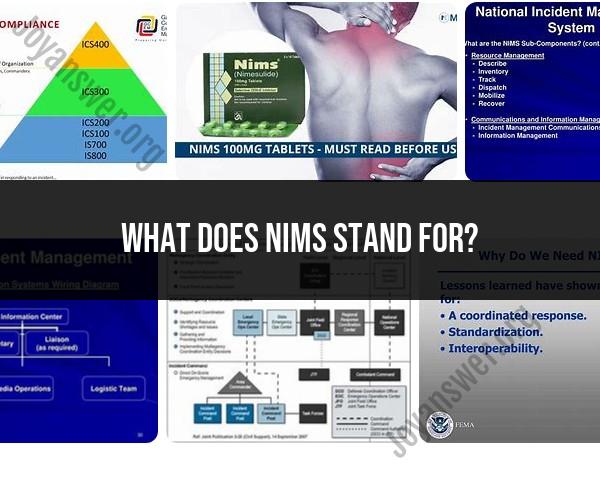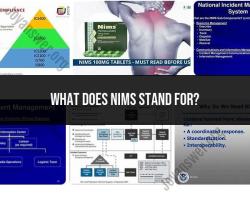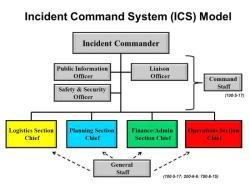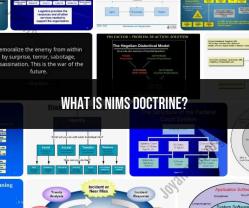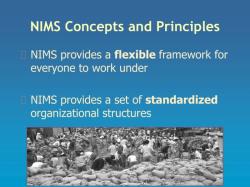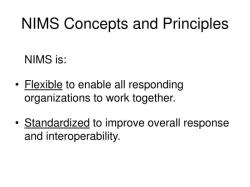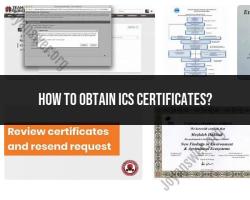What does NIMS stand for?
NIMS stands for the National Incident Management System. NIMS is a comprehensive and standardized approach to incident management and response in the United States. It provides a set of principles, concepts, and procedures to enable effective, coordinated, and collaborative incident management at all levels of government, across all functional disciplines, and with private sector and non-governmental organizations.
The primary goal of NIMS is to enhance the nation's ability to manage and respond to incidents, including natural disasters, acts of terrorism, and other emergencies, by establishing a common framework and language for incident management. It promotes interoperability and consistency in the way various agencies and organizations respond to and coordinate during incidents.
NIMS outlines key components, including the Incident Command System (ICS), multi-agency coordination systems, training, resource management, and communication protocols, among others. The system is designed to be scalable and adaptable to incidents of varying sizes and complexities. NIMS is a critical component of the United States' emergency management and response efforts.
NIMS: Unifying Emergency Response Across the Nation
1. Full Form and Significance:
The full form of NIMS is National Incident Management System. It's a standardized approach to incident management, enabling all levels of government, non-governmental organizations, and the private sector to work together seamlessly during emergencies. NIMS promotes:
- Unified terminology and procedures: Ensures everyone speaks the same language and follows consistent protocols, regardless of their background or jurisdiction.
- Effective resource allocation: Optimizes the use of personnel, equipment, and other resources across agencies.
- Improved coordination and communication: Facilitates collaboration between different entities, leading to faster and more effective response.
2. NIMS in Action:
NIMS functions through a set of core principles and guiding components. These guide how incidents are managed at all levels, from planning and preparedness to response, recovery, and mitigation. Key elements include:
- Incident Command System (ICS): Provides a standard organizational structure for managing incidents of any size or complexity.
- Resource Management: Streamlines the deployment and utilization of personnel, equipment, and other resources.
- Communications and Information Management: Ensures timely and accurate sharing of information among all stakeholders.
- Training and Professional Development: Equips personnel with the knowledge and skills needed to effectively implement NIMS.
3. Key Principles and Components:
NIMS is anchored by six core principles:
- Unity of Effort: All responders work towards a common goal.
- Common Task Language: Everyone uses the same terminology.
- Flexible and Scalable: Adapts to incidents of any size or complexity.
- Standardized Processes: Consistent procedures ensure efficient response.
- Interoperability:** Different agencies and jurisdictions can work together seamlessly.
- Public Information and Stakeholder Engagement:** Keeps the public informed and involved.
The four main components of NIMS are:
- Management Systems: ICS, resource management, communications, and information management.
- Personnel Qualifications: Training and credentialing standards for different roles.
- Technology and Data Sharing: Tools and platforms for information exchange.
- Planning and Preparedness: Developing response plans and training exercises.
4. Aiding Emergency Response:
NIMS plays a crucial role in emergency response by:
- Improving coordination and communication: Different agencies can work together effectively, avoiding confusion and duplication of efforts.
- Optimizing resource allocation: Ensures the right resources are deployed to the right place at the right time.
- Saving lives and property: Faster and more effective response leads to better outcomes for those affected by emergencies.
- Building resilience: Standardized procedures and training help communities prepare for and recover from disasters.
5. Historical Background and Evolution:
NIMS emerged in the aftermath of major disasters like the 1993 Northridge earthquake and the 1992 Los Angeles riots, which exposed the need for a more coordinated approach to incident management. In 2003, the Department of Homeland Security established the National Incident Management System Integration Center (NIC) to develop and implement NIMS nationwide. Since then, NIMS has undergone continuous improvement and adaptation to address evolving threats and challenges.
By fostering collaboration and efficiency, NIMS has become a cornerstone of emergency preparedness and response in the United States. Its standardized approach ensures that, when disaster strikes, communities can come together and respond as one.
I hope this comprehensive overview clarifies NIMS and its significance! Feel free to ask any further questions you may have.
